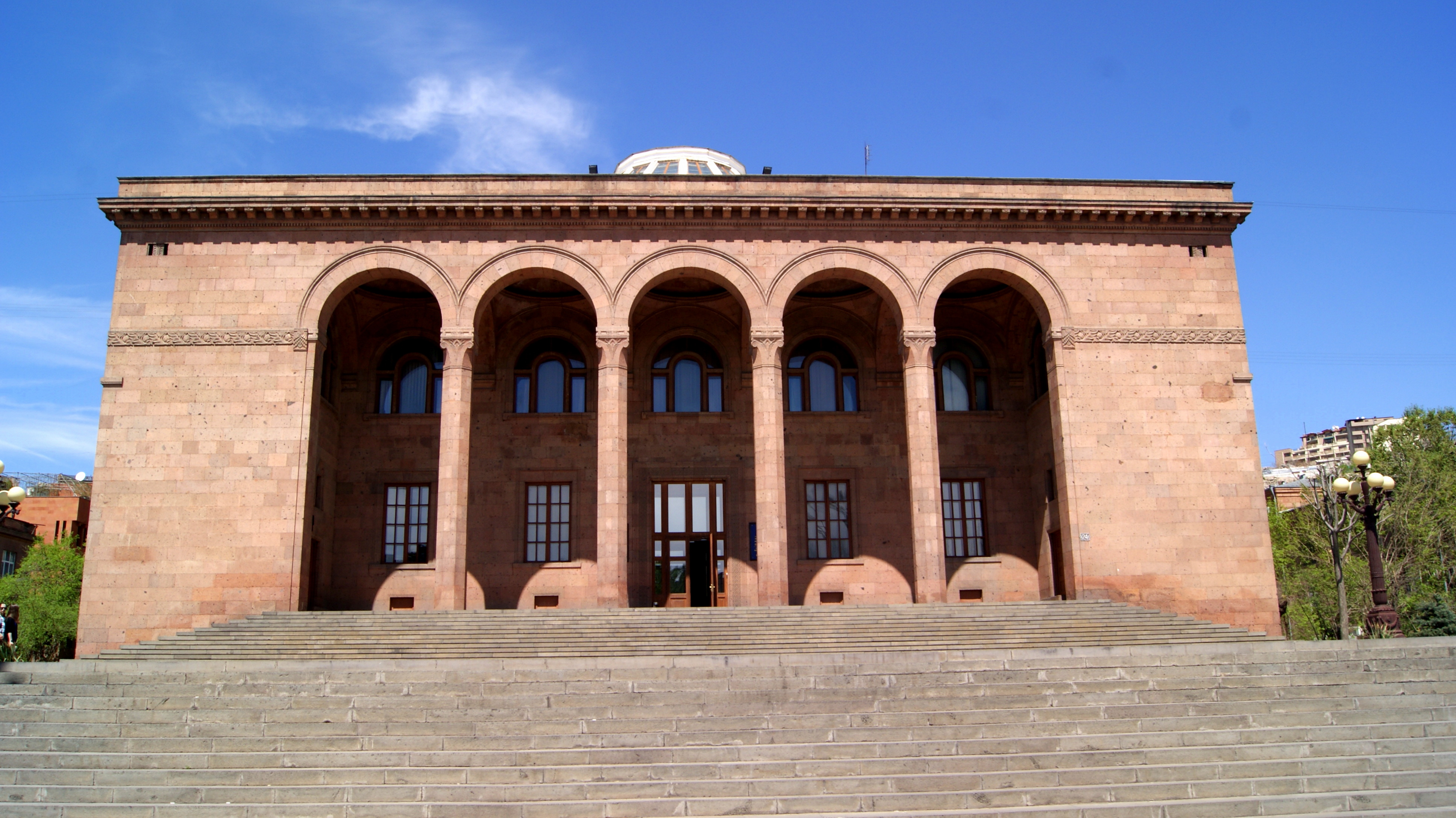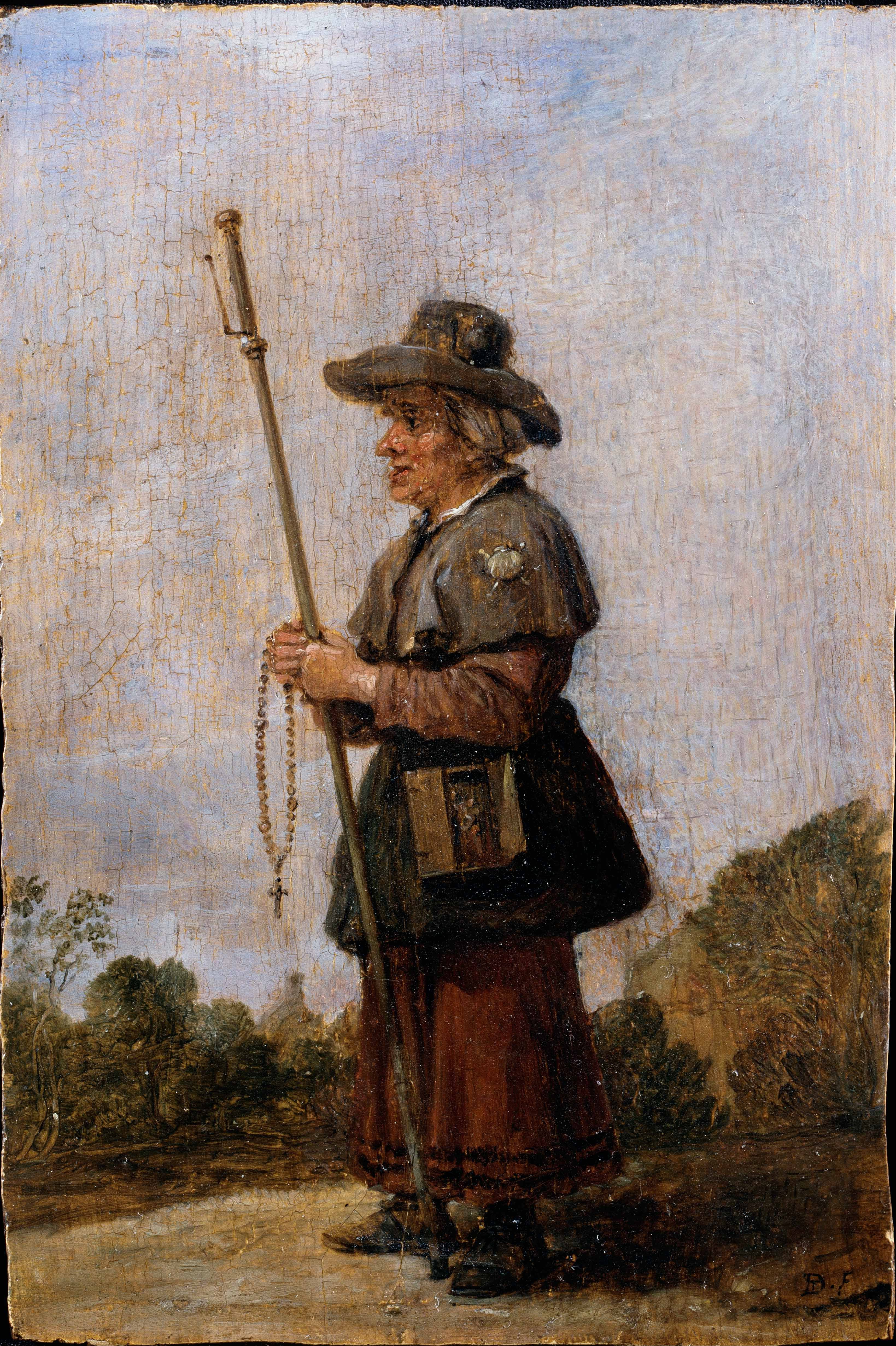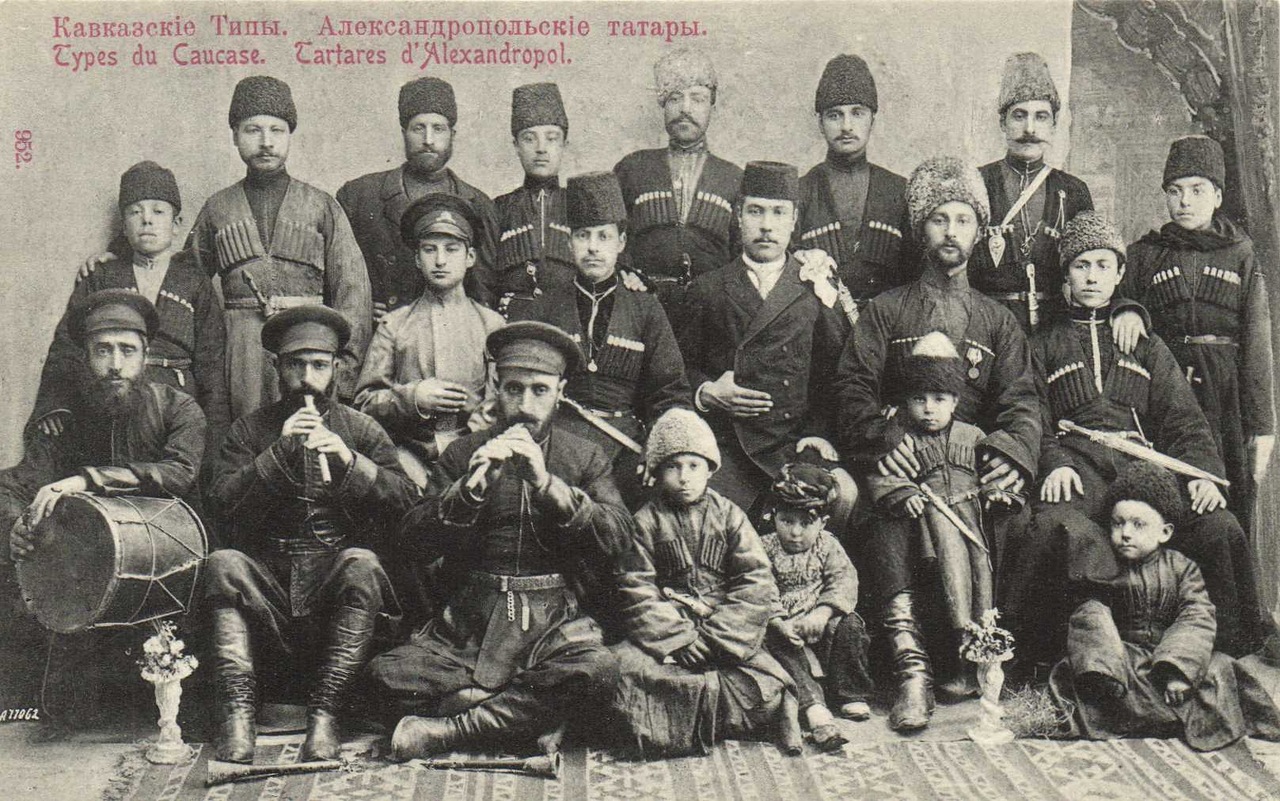|
Baba-Hadji Mausoleum
The Baba-Hadji Mausoleum is an Islamic Mausoleum and shared Armenian- Azerbaijani pilgrimage site built in the late 16th or early 17th century and located near the Shvanidzor village of Armenia some seventeen kilometres to the east of Meghri. In 1926 Lisitsian wrote that: "Baba Haji was a Turk and Armenian pilgrimage site not very far from the abandoned Armenian village of Gyumerants or Gumerants, and near the former Armenian village Bolishen." The Mausoleum is listed as a protected site for the cultural heritage of the ethnic minorities of Armenia by the government under the “Non-Armenian historical and cultural Monuments in Syunik” category and is maintained as state property. Architecture The mausoleum sits on the crest of a hill, encircled by the arm of an oak tree. It is conical with a diameter of roughly six metres and a height in the inner chamber of just under four. It is made of stone and contains a small square enclosure within covered in black cloth, surrounding ... [...More Info...] [...Related Items...] OR: [Wikipedia] [Google] [Baidu] |
Islam
Islam (; ar, ۘالِإسلَام, , ) is an Abrahamic monotheistic religion centred primarily around the Quran, a religious text considered by Muslims to be the direct word of God (or ''Allah'') as it was revealed to Muhammad, the main and final Islamic prophet.Peters, F. E. 2009. "Allāh." In , edited by J. L. Esposito. Oxford: Oxford University Press. . (See alsoquick reference) " e Muslims' understanding of Allāh is based...on the Qurʿān's public witness. Allāh is Unique, the Creator, Sovereign, and Judge of mankind. It is Allāh who directs the universe through his direct action on nature and who has guided human history through his prophets, Abraham, with whom he made his covenant, Moses/Moosa, Jesus/Eesa, and Muḥammad, through all of whom he founded his chosen communities, the 'Peoples of the Book.'" It is the world's second-largest religion behind Christianity, with its followers ranging between 1-1.8 billion globally, or around a quarter of the world' ... [...More Info...] [...Related Items...] OR: [Wikipedia] [Google] [Baidu] |
Armenian National Academy Of Sciences
The National Academy of Sciences of the Republic of Armenia (NAS RA) ( hy, Հայաստանի Հանրապետության գիտությունների ազգային ակադեմիա, ՀՀ ԳԱԱ, ''Hayastani Hanrapetut’yan gitut’yunneri azgayin akademia'') is the Armenian national academy, functioning as the primary body that conducts research and coordinates activities in the fields of science and social sciences in Armenia. It is a member of the International Science Council. History The Academy of Sciences of the Armenian Soviet Socialist Republic was founded on 10 November 1943, on the basis of the Armenian Branch of the Soviet Academy of Sciences, which was established almost 10 years earlier, in 1935. Among its founders were Joseph Orbeli, Stepan Malkhasyants, Ivan Gevorkian and Victor Ambartsumian; Orbeli became the first president of the academy. Presidents * Joseph Orbeli (1943–1947) * Victor Ambartsumian (1947–1993) * Fadey Sargsyan (1993–2006) * Radik ... [...More Info...] [...Related Items...] OR: [Wikipedia] [Google] [Baidu] |
Religious Buildings And Structures In Armenia
Religion is usually defined as a social-cultural system of designated behaviors and practices, morals, beliefs, worldviews, texts, sanctified places, prophecies, ethics, or organizations, that generally relates humanity to supernatural, transcendental, and spiritual elements; however, there is no scholarly consensus over what precisely constitutes a religion. Different religions may or may not contain various elements ranging from the divine, sacred things, faith,Tillich, P. (1957) ''Dynamics of faith''. Harper Perennial; (p. 1). a supernatural being or supernatural beings or "some sort of ultimacy and transcendence that will provide norms and power for the rest of life". Religious practices may include rituals, sermons, commemoration or veneration (of deities or saints), sacrifices, festivals, feasts, trances, initiations, funerary services, matrimonial services, meditation, prayer, music, art, dance, public service, or other aspects of human culture. Religions have ... [...More Info...] [...Related Items...] OR: [Wikipedia] [Google] [Baidu] |
Pilgrimage Sites
A pilgrimage is a journey, often into an unknown or foreign place, where a person goes in search of new or expanded meaning about their self, others, nature, or a higher good, through the experience. It can lead to a personal transformation, after which the pilgrim returns to their daily life. Background Pilgrimages frequently involve a journey or search of moral or spiritual significance. Typically, it is a journey to a shrine or other location of importance to a person's beliefs and faith, although sometimes it can be a metaphorical journey into someone's own beliefs. Many religions attach spiritual importance to particular places: the place of birth or death of founders or saints, or to the place of their "calling" or spiritual awakening, or of their connection (visual or verbal) with the divine, to locations where miracles were performed or witnessed, or locations where a deity is said to live or be "housed", or any site that is seen to have special spiritual powers. ... [...More Info...] [...Related Items...] OR: [Wikipedia] [Google] [Baidu] |
Azerbaijanis In Armenia
Azerbaijanis in Armenia ( az, Ermənistan azərbaycanlıları or Qərbi azərbaycanlılar, lit=Western Azerbaijanis) numbered 29 people according to the 2001 census of Armenia. Although they have previously been the biggest minority in the country according to 1831–1989 censuses, they are virtually non-existent since 1988–1991 when most fled or were forced out of the country as a result of the tensions of the First Nagorno-Karabakh War to neighboring Azerbaijan. The UNHCR estimates that the current population of Azerbaijanis in Armenia to be somewhere between 30 and a few hundred people,Second Report Submitted by Armenia Pursuant to Article 25, Paragraph 1 of the Framework Convention for the Protecti ... [...More Info...] [...Related Items...] OR: [Wikipedia] [Google] [Baidu] |
Islam In Armenia
Islam began to make inroads into the Armenian Plateau during the seventh century. Arab, and later Kurdish, tribes began to settle in Armenia following the first Arab invasions and played a considerable role in the political and social history of Armenia. Ter-Ghewondyan, Aram (1976). ''The Arab Emirates in Bagratid Armenia''. Trans. Nina G. Garsoïan. Lisbon: Calouste Gulbenkian Foundation. With the Seljuk invasions of the eleventh and twelfth centuries, the Turkic element eventually superseded that of the Arab and Kurdish. With the establishment of the Iranian Safavid dynasty, Afsharid dynasty, Zand Dynasty and Qajar dynasty, Armenia became an integral part of the Shia world, while still maintaining a relatively independent Christian identity. The pressures brought upon the imposition of foreign rule by a succession of Muslim states forced many lead Armenians in Anatolia and what is today Armenia to convert to Islam and assimilate into the Muslim community. Many Armenians were ... [...More Info...] [...Related Items...] OR: [Wikipedia] [Google] [Baidu] |
Azerbaijan
Azerbaijan (, ; az, Azərbaycan ), officially the Republic of Azerbaijan, , also sometimes officially called the Azerbaijan Republic is a transcontinental country located at the boundary of Eastern Europe and Western Asia. It is a part of the South Caucasus region and is bounded by the Caspian Sea to the east, Russia ( Republic of Dagestan) to the north, Georgia to the northwest, Armenia and Turkey to the west, and Iran to the south. Baku is the capital and largest city. The Azerbaijan Democratic Republic proclaimed its independence from the Transcaucasian Democratic Federative Republic in 1918 and became the first secular democratic Muslim-majority state. In 1920, the country was incorporated into the Soviet Union as the Azerbaijan SSR. The modern Republic of Azerbaijan proclaimed its independence on 30 August 1991, shortly before the dissolution of the Soviet Union in the same year. In September 1991, the ethnic Armenian majority of the Nagorno-Karabakh region for ... [...More Info...] [...Related Items...] OR: [Wikipedia] [Google] [Baidu] |
Nyuvadi
Nrnadzor ( hy, Նռնաձոր) is a village in the Meghri Municipality of the Syunik Province in Armenia, on the bank of the Aras River. History The village of Nrnadzor (meaning "pomegranate canyon" in Armenian, also the name of a nearby tributary of the Aras) was previously called Nyuvadi (; ). During the Russian Empire, the village was a part of the Zangezur uezd of the Elizavetpol Governorate. The village was transferred from the Azerbaijan SSR to the Armenian SSR in 1928. The Azerbaijani-speaking population of the village fled in the summer of 1991 in the context of the Nagorno-Karabakh conflict, after which the village was repopulated by Armenians who fled from different parts of Azerbaijan. The exact date the Azerbaijani population departed was 8 August 1991 – the local administration ensuring their peaceful departure without violence. On 4 July 2006, the village was renamed to its current name. Demographics The population is engaged with viticulture, fruit gr ... [...More Info...] [...Related Items...] OR: [Wikipedia] [Google] [Baidu] |
OpenDemocracy
openDemocracy is an independent media platform and news website based in the United Kingdom. Founded in 2001, openDemocracy states that through reporting and analysis of social and political issues, they seek to "challenge power and encourage democratic debate" around the world. The founders of the website have been involved with established media and political activism. The platform has been funded by grants from organisations such as Charles Stewart Mott Foundation, the Open Society Foundations, the Ford Foundation, and Joseph Rowntree Charitable Trust, as well as by receiving direct donations from readers. History openDemocracy was founded in 2000 by Anthony Barnett, David Hayes, Susan Richards and Paul Hilder. First publication began in May 2001. Founder Anthony Barnett, Charter 88 organiser and political campaigner, was the first editor (2001–2005) and Isabel Hilton was editor from 2005 to 2007. She was succeeded in 2010 by Rosemary Bechler, who in turn handed o ... [...More Info...] [...Related Items...] OR: [Wikipedia] [Google] [Baidu] |
Shvanidzor, Syunik
Shvanidzor ( hy, Շվանիձոր, ) is a village in the Meghri Municipality of the Syunik Province in southeastern Armenia, near Armenia's border with Iran. Toponymy The village is also known as ''Astazur'' and ''Shvandor''. History According to local historical sources, Shvanidzor was founded in the 13th century, and at the time counted more than 700 households, and was located in the place of the historic settlement of ''Areviq''. The lands of the community were cultivated for more than 700 years, which resulted in the formation of agricultural landscapes. Due to the lack of irrigation and lowland fertility, the community was relocated several times. In the vicinity of the village, there are numerous remnants of 17th- and 18th-century dwellings. The community is known for its medieval ''kahrezes'' ( qanat), a system of underground water channels and intake facilities. These deep channels are located 50-60m from each other. There are 5 kahrezes in Shvanidzor. Four of them ... [...More Info...] [...Related Items...] OR: [Wikipedia] [Google] [Baidu] |
Meghri
Meghri ( hy, Մեղրի) is a town and the center of the urban community of Meghri, in Syunik Province in southern Armenia, near the border with Iran. As of the 2011 census, the population of the town was 4,580. According to the 2020 official estimate, Meghri's population is around 4,500. Meghri is located 376 km south of the capital Yerevan and 73 km south of the provincial capital Kapan. As a result of the community mergers in 2016, the municipality of Meghri was enlarged to include the surrounding villages of Agarak, Alvank, Aygedzor, Gudemnis, Karchevan, Kuris, Lehvaz, Lichk, Nrnadzor, Shvanidzor, Tashtun, Tkhkut, Vahravar, and Vardanidzor. Etymology Meghri was founded as "Karchavan" in 906 by king Smbat I of Armenia, during the period of the Bagratid Kingdom of Armenia. Later, it was known as Meghri, meaning "honey town" in the Armenian language. History Ancient history and Middle Ages The area of present-day Meghri has been settled since the ... [...More Info...] [...Related Items...] OR: [Wikipedia] [Google] [Baidu] |
Armenia
Armenia (), , group=pron officially the Republic of Armenia,, is a landlocked country in the Armenian Highlands of Western Asia.The UNbr>classification of world regions places Armenia in Western Asia; the CIA World Factbook , , and ''Oxford Reference Online'' also place Armenia in Asia. It is a part of the Caucasus region; and is bordered by Turkey to the west, Georgia to the north, the Lachin corridor (under a Russian peacekeeping force) and Azerbaijan to the east, and Iran and the Azerbaijani exclave of Nakhchivan to the south. Yerevan is the capital, largest city and the financial center. Armenia is a unitary, multi-party, democratic nation-state with an ancient cultural heritage. The first Armenian state of Urartu was established in 860 BC, and by the 6th century BC it was replaced by the Satrapy of Armenia. The Kingdom of Armenia reached its height under Tigranes the Great in the 1st century BC and in the year 301 became the first state in the worl ... [...More Info...] [...Related Items...] OR: [Wikipedia] [Google] [Baidu] |
.jpg)






.jpg)